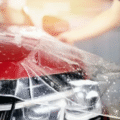Graphene Coating vs. Ceramic Coating: What’s the Future of Car Paint Protection
Car owners always want their vehicles to look new and well-maintained. However, maintaining the glossy finish of a car is challenging due to dust, dirt, UV rays, and scratches. To protect the car’s paint and extend its lifespan, car owners turn to advanced protective coatings.
Two popular options today are Graphene Coating and Ceramic Coating. While ceramic coatings have been widely used for years, graphene coatings are emerging as a newer and more advanced alternative. But which one is better for long-term protection What are the key differences between the two
In this blog, we will explore Graphene Coating vs. Ceramic Coating, comparing their benefits, durability, and overall effectiveness to help car owners make an informed decision about paint protection.

What is Ceramic Coating
Understanding Ceramic Coating
Ceramic coating is a liquid polymer applied to a car’s exterior. It creates a chemical bond with the car’s paint, forming a protective layer. This layer helps protect the car from dirt, water spots, UV rays, and minor scratches.
Key Benefits of Ceramic Coating
- Hydrophobic Properties Water and dirt slide off easily, making it easier to clean the car
- UV Protection Prevents sun damage and fading of the car’s paint
- Chemical Resistance Protects the paint from harsh chemicals, bird droppings, and acid rain
- Glossy Finish Adds a deep shine, enhancing the car’s appearance
- Long Lasting Protection Can last between two to five years, depending on the quality of the application
Limitations of Ceramic Coating
- Not Scratch Proof Reduces minor scratches but does not prevent deep scratches
- Water Spot Issues While water beads up, mineral deposits can still be left behind
- Higher Cost Professional application can be expensive
- Limited Flexibility Ceramic coatings are rigid, which may lead to cracking over time
What is Graphene Coating
Understanding Graphene Coating
Graphene coating is a newer and more advanced form of car paint protection. It is made from graphene, which is a single layer of carbon atoms arranged in a hexagonal structure. This material is one of the strongest known to science, providing exceptional durability and flexibility.
Graphene coatings work similarly to ceramic coatings but offer improved hydrophobic properties, heat resistance, and durability.
Key Benefits of Graphene Coating
- Stronger and More Durable Graphene is 200 times stronger than steel, making the coating highly resistant to damage
- Superior Hydrophobic Properties Water slides off more efficiently than with ceramic coatings, reducing water spots
- High Heat Resistance Prevents paint oxidation and water evaporation stains
- Flexible Material Unlike ceramic coatings, graphene coatings are flexible, preventing cracking over time
- Anti Static Properties Repels dust, keeping the car cleaner for longer periods
- Longer Lifespan Can last between five to seven years with proper maintenance
Limitations of Graphene Coating
- Higher Cost Graphene coatings are more expensive than ceramic coatings
- Limited Availability Fewer professional detailers currently offer graphene coating services
- Requires Professional Application Best results are achieved when applied by experts
Graphene Coating vs. Ceramic Coating A Detailed Comparison
To help you decide which coating is better for your car, here is a detailed comparison based on key factors
Durability
Ceramic coatings typically last between two to five years, while graphene coatings can last up to seven years or more with proper care. Graphene offers a longer lifespan due to its superior strength.
Hydrophobic Properties
While both coatings repel water, graphene coatings provide better water beading and sheeting. This means that water rolls off more easily, reducing the chances of water spots forming on the paint.
Heat Resistance
Graphene coatings offer superior heat resistance compared to ceramic coatings. This helps prevent paint oxidation, which occurs when excessive heat causes the paint to deteriorate.
Scratch Resistance
Neither coating is completely scratch proof, but graphene coatings provide slightly better resistance against minor scratches due to their stronger and more flexible nature.
Dust and Dirt Repellency
Graphene coatings have anti static properties, which help repel dust and dirt. This feature helps keep the car cleaner for a longer period compared to ceramic coatings.
Flexibility
Ceramic coatings are rigid and can crack over time, especially when exposed to extreme weather conditions. Graphene coatings, on the other hand, are flexible and adapt to the surface, reducing the chances of cracking.
Ease of Maintenance
Both coatings reduce the need for frequent car washes, but graphene coatings are easier to maintain due to their dust repellent properties.
Cost
Graphene coatings are generally more expensive than ceramic coatings. However, their longer lifespan and superior protection may justify the higher price for many car owners.
Which Coating is Best for You
The choice between Graphene Coating and Ceramic Coating depends on your budget, needs, and how you use your car.
Choose Ceramic Coating If
- You are looking for a cost effective paint protection solution
- You want a deep, glossy finish that enhances your car’s appearance
- You do not mind reapplying the coating every few years
- You are comfortable with occasional water spots and dirt buildup
Choose Graphene Coating If
- You want the latest and most advanced paint protection technology
- You need a long lasting solution that provides up to seven years of protection
- You live in a hot climate and need superior heat resistance
- You prefer a coating that repels dust, water, and dirt more effectively than ceramic coatings
- You want a flexible coating that does not crack over time
The Future of Car Paint Protection
As technology advances, the future of car paint protection is moving towards more durable, advanced, and eco friendly coatings. Some future trends to watch include
- Wider Adoption of Graphene Coatings As graphene becomes more affordable and widely available, it is likely to become the preferred choice for car owners
- Self Healing Coatings Research is underway to develop coatings that can automatically repair minor scratches
- Eco Friendly Solutions Future coatings may be water based and made from biodegradable materials to reduce environmental impact
- Smart Coatings Innovations in nano coatings may lead to self cleaning or even color changing properties
Conclusion Which One Should You Choose
Both Graphene Coating and Ceramic Coating offer excellent protection for your car. However, graphene coating is the future of car paint protection due to its superior durability, heat resistance, and hydrophobic properties.
That said, ceramic coating remains a great option for those who want a cost effective and reliable way to protect their car’s paint.
Final Advice
- If you plan to keep your car for many years and want the best protection, graphene coating is the ideal choice
- If you want a budget friendly option with solid protection, ceramic coating is still a great choice
No matter which coating you choose, regular maintenance and professional application will ensure that your car looks shiny, sleek, and protected for years to come.
We hope this guide helps you make the best decision for your car’s paint protection. Whether you choose graphene or ceramic coating, both are excellent ways to maintain your car’s beauty and value over time.










